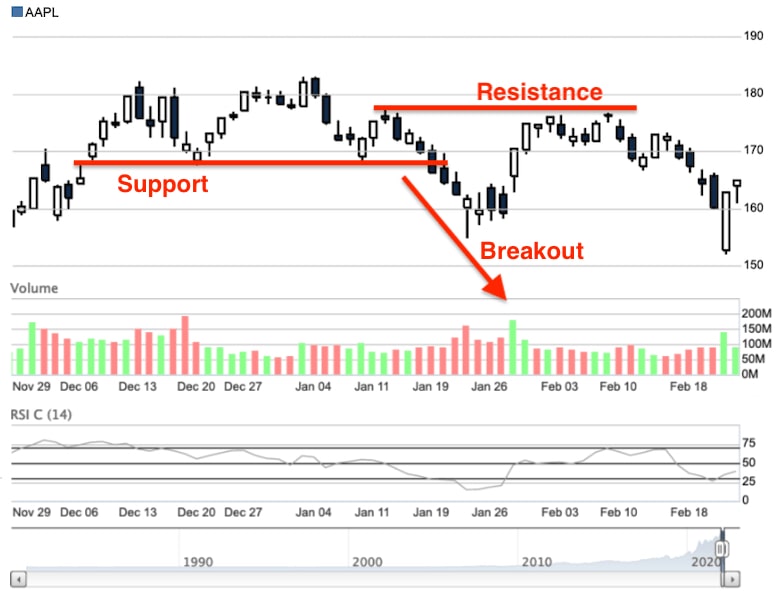Whenever a stock listed in the stock market is about to take upward growth, investors want to know it first using certain ways. One such way to find the big move of selected stock is called breakout trading.
In this article, we will explain the term breakout and breakout trading. You will also learn how to use breakout trading, its features, and methods to find breakout points.
What is Breakout?
The term ‘breakout’ in the share market represents the stock price moving beyond the defined support or resistance level. Generally, breakouts take place with heavy volumes and increased volatility amounts.
A breakout trader enters into the market to buy the stock or commodities when the stock price goes beyond the price level of ceiling or resistance or sell the owned stocks or commodities when the stock price falls below the support or floor price level.

In most cases, the breakout is considered a situation when the price of a selected stock breaks out at the above level of resistance and goes beyond its initial resistance.
How to Find Breakout Stocks or Indicators?
You have learned about breakout points and stocks. Now it’s time to know how to find such breakout points to find profitable trading opportunities.
- First, you must remember that a breakout in intraday means an upward trend above the resistance or a downward trend below the support price. When finding breakout points, you will be using these two.
- You will come to the very first support and resistance price of the selected stock or commodity and see its past upward and downward trends.
- Based on its last swing’s up and down trends, you will gauge the short-term support and resistance level.
- You can further analyze some crucial support and resistance price levels.
- Once you execute the steps mentioned earlier, take up the ideal trading chart and start comparing the trend line as well as the moving average.
Finding a breakout point is simple, but it requires proper time and experience to make accurate predictions.
Why are Breakouts Important?
Traders and investors analyze breakout points in technical analysis to figure out selected stocks’ initial upward or downward trends. These breakouts often include price action and renewed volatility, making them ideal for finding profitable trading opportunities.
Breakout analysis and trading are very simple to understand. For example, if a stock’s price revolves around Rs 1,000 multiple times, you will hardly wish to buy that stock to make a further profit. However, if the same stock’s price goes beyond Rs 1,000, you will start putting your efforts into buying it and get better ROI in future trading.
Types of Breakouts
1. Reversal
The reversal breakout in the share market occurs when a shart downtrend happens in the prices of stocks and spikes much higher with high volume. Generally, this type of breakout happens because of frantic short-covering and bargain shoppers that are flooding in stock. This trade is also affected by breaking news or rumors about a particular stock and commodity.
2. Consolidation
Sometimes stock breakouts can take place after a consolidated period. It is described as flat trading, where prices of stock or commodities stay within the predefined trading ranges with light volume. In this breakout trading, the initial trends can be defined using various chart indicators, trendlines, and moving averages. Moreover, here trading volume shows the lack of interest from the sellers or buyers.
3. Triangle
In this type of breakout, the resistance level stays flat, but the support level can rise exponentially. This type of breakout event shows that buyers are impatient to buy such stocks, and there is a slow uptrend in bid prices to impact pullbacks. However, there are few pullbacks because most buyers buy the stocks in bulk through resistance. This type of stock breakout can be figured out in the ascending triangle breakout patterns.
How to Start Breakout Trading in the Stock Market?
Below are some straightforward phases you can follow to start doing breakout trading.
1. Define the Price Range and Highlight the Price Level
To start breakout trading successfully, you must first decide on the selected stock’s price range. But you must be careful and use your analytic skills to find a precise price range, which is normally V shape swing high. It can be a breakout trading level that you will use for further trading.
2 Wait for Stock Price Break
The second step includes figuring out the resistance level and then waiting for stock breakouts. Let your breakout trading strategy slowly happen and wait for some time. To execute breakout trading successfully, you will require a breakout point and the candle to close the trade on over resistance level. Here the trades are controlled by bulls as its bullish in nature.
3. Get Script at Breakout Candle
Now you need to get your scripts where the breakout candle is the closing price, where the volume-weighted moving average is scratching up. In short, you will be required to confirm your trading using the VNMA breakout indicator and analyze if it stretches up. Try to ensure that the upward trend is more inclined towards the upside.
Conclusion
A breakout is a trading opportunity where traders can make significant profit by selling or buying stocks in the stock market. Here the stock prices mostly move beyond the resistance level, or they can also move below the support price once the trade volume increases.
So, when executing your breakout trading, it’s essential to get a proper idea about current stock price trends and their support as well as resistance price levels to decide your entry and exit points. As breakout points indicate that new upward or downward trends are forming, it’s crucial to carefully decide your entry and exit.
Furthermore, you should refrain from executing breakout trading if there is a stock breakout against the potential dominant pressure. You should also avoid this strategy if you cannot find any feasible trading range of consolidation on stock breakouts.
